lordroel
Administrator
Posts: 68,086 
Likes: 49,473
|
Post by lordroel on Jun 5, 2022 6:15:55 GMT
Day 1362 of World War II, June 5th 1943Eastern Front The Luftwaffe launched a series of heavy raids on Kursk, the pivotal point of the Russian salient which bulged dangerously into the German lines between Orel, in the north and Kharkov in the south. Despite the withdrawal of fighter squadrons to face the growing threat of Allied bombers in the west, and the need to reinforce the Mediterranean, the Germans were able to rebuild Field Marshal von Richtohofen's Luftlotte 4 into a powerful striking force. His Stukas and Bf 109s were joined by Henschel 129 tankbusters and Focke-Wulf Fw 190 fighters. However, the Luftwaffe, like the Wehrmacht, was devoting a significant part of its strength to containing the threat posed by the Russian partisans who now had their own airstrips behind the German lines. These were used to deliver supplies and evacuate wounded partisans and peasants. A report today on the current anti-partisan Operation 'Cottbus' said that these airstrips take twin-engined aircraft. Moscow claimed the destruction of 752 German aircraft in combat and on the ground in the week ended 5 June for loss of 212 Russian aircraft, and reported that during May the enemy had lost 2069 planes on the Eastern front. Air War over Europe12 aircraft went minelaying in the Frisians. No losses. Battle of the AtlanticOperations outside the North Atlantic prove to be more successful for the Germans as 'U-513' sinks 4 ships off the coast of Brazil. But losses for the German wolf packs continued. 'U-217' (Type VIID) was sunk in the mid-Atlantic by depth charges from Avenger aircraft of the US escort carrier USS 'Bogue'. Battle of the MediterraneanBritish ships kept up the heavy shelling of Pantelleria Island. During the night, Northwest African Air Force Wellingtons hit docks and the town area of Pantelleria Island in the Mediterranean. During the day, B-25s and P-38 Lightnings extended the attack on the island, hitting mainly gun positions. German fighter opposition, extremely light at first, picked up when Bf 109s and Fw 190s appeared along with Italian fighter aircraft. During the early morning, Royal Air Force (RAF) heavy bombers, under operational control of the IX Bomber Command, attacked the harbor at Catania, Sicily. In Sardinia, B-26s bombed Porto Ponte Romano while P-38s hit airfields at Monserrato and Capoterra. United StatesBoeing engineers start preliminary studies for developing a jet-powered aircraft. Photo: Launch of the U.S. Navy escort carrier USS Guadalcanal (CVE-60) at Kaiser Shipyards, Vancouver, Washington (USA), on 5 June 1943 Pacific War Pacific WarALEUTIAN ISLANDS CAMPAIGN I-175 lands a ton of weapons and ammunition and 15 tons of food and then evacuates 56 sailors and four Japanese civilians. In the Aleutian Islands, 7 B-24's, 6 B-25's, and 6 P-40's fly weather reconnaissance and radar-bombing missions over Kiska Island, being handicapped by poor weather and mechanical trouble. JAPANESE OCCUPIED PHILIPPINES The submarine USS Nautilus lands 90 tons of supplies on Mindanao Island, Philippine Islands and an officer tasked with establishing a communications network. CHINA (Fourteenth Air Force) In China, P-40's strafe troop columns near Peiyang and hit a barge and boat NW of Yoyang. NEW GUINEA CAMPAIGN In the early morning, a formation of B-17s bombed Japanese installations at Kahili, Buin area. At about noon of the same day a formation of SBD's and TBF's , escorted by P-40's, F4U's and P-38's fighters, attacked a Japanese destroyer, a corvette and a cargo vessel in the Bougainville area. Several large bomb hits were scored on the destroyer which undoubtedly sank. The corvette and the cargo vessel were set on fire. In the above action the U. S. attacking planes were engaged by a large force of Japanese Zero fighters. U. S. pilots shown down 15 Zeros and damaged 3 others. Four U. S. planes are missing. Lost are: PBY 08078, SBD-3 06520, SBD-3 06524, SBD 06683 and F4U 02499 VMF-112 (lost over Russells). SOUTH PACIFIC THEATER OF OPERATIONS (Thirteenth Air Force) The 394th Bombardment Squadron (Heavy), 5th BG which has been operating from Guadalcanal Island with B-24's since 25 Apr 43 returns to it's base on Fiji. SOUTHWEST PACIFIC THEATER OF OPERATIONS (Fifth Air Force) HQ 345th Bombardment Group (Medium) and it's 498th, 499th, 500th and 501st Bombardment Squadrons arrive with B-25's at Port Moresby from the US. The group will fly it's first mission on 21 Jun. Lost on a reconnaissance mission to New Britain is F5A Lightning 42-13073 (pilot later rescued).
|
|
lordroel
Administrator
Posts: 68,086 
Likes: 49,473
|
Post by lordroel on Jun 6, 2022 6:36:01 GMT
Day 1363 of World War II, June 6th 1943Air War over Europe General Franco proposes "no-bombing" zones in Europe. The Allies reject the idea as beneficial to the Axis. Battle of the MediterraneanThe bombardment of the island of Pantelleria continued into its third consecutive day. During the night, Northwest African Strategic Air Force (NASAF) Wellingtons hit the town and docks of the Island. The following afternoon, Spitfires, P-40s, P-38s, B-26 Marauders, A-20 Havocs, A-36 Apaches, and B-25 Mitchells of the NASAF, Northwest African Tactical Air Force (NATAF) and USAAF Ninth Air Force continued pounding the island. The Allied air bombardment increased and was concentrated on coastal batteries and other gun emplacements as the second phase of air offensive against Pantelleria Island started. In Italy, B-24's struck the harbor areas of Villa San Giovanni and Reggio di Calabria, and ferry slips and railroad yards at Messina. B-24 gunners claimed 8 fighters destroyed. Photo: Resting in blast-wall protected Dispersal Point 125 at Luqa, a Bristol Beaufort Mark II of No 39 Squadron, Royal Air Force is attended to by ground crew, June 1943 Photo: With Mdina in the background, Bristol Beaufighter Mark VIF 'F-Freddie' of No 272 Squadron, Royal Air Force on the taxiway at Ta Kali, June 1943 Photo: With Mdina in the background, Bristol Beaufighter Mark VIF 'F-Freddie' of No 272 Squadron, Royal Air Force on the taxiway at Ta Kali, June 1943 Photo: A flight of Bristol Beaufighters of No 272 Squadron, Royal Air Force on patrol off Malta, June 1943 Photo: A flight of Bristol Beaufighters of No 272 Squadron, Royal Air Force on patrol off Malta, June 1943 Battle of the Indian Ocean Battle of the Indian OceanU.S. tanker William King is torpedoed and sunk by German submarine U-198 off the South African coast, 30°34'S, 33°56'E; while six of the 42-man merchant complement perish in the sinking, there are no casualties among the 23-man Armed Guard. U-198 surfaces and brings the lifeboats alongside, however, and takes ship's master Owen H. Reed prisoner before departing. North AfricaIn a speech ironically delivered a year to the day prior to the Allied invasion of Normandy, General de Gaulle, to the Free (Fighting) French, called for a fourth republic. His appeal for "national renovation" was being taken by observers here to mean that he did not intend France to return to the pre-war constitution of the Third Republic. De Gaulle also told his audience that; "France does not want to be liberated by others, even by her best friends. She does not want gifts. We intend win our liberty ourselves."Pacific WarALEUTIAN ISLANDS CAMPAIGN In the Aleutian Islands, the Japanese submarine I-24 reports that it is approaching Kiska to land supplies and evacuate personnel. The sub is never heard from again. CHINA (Fourteenth Air Force) In China, 5 P-40's strafe trucks, barracks, and personnel at Tangyang; at least 15 trucks are burned and considerable damage is done to the barracks area. 11 P-40's hit the approaches to a bridge at Puchi; 2 locomotives in the area are destroyed. 10 other P-40's attack Shasi Airfield and hit river shipping; in the general area. 7 B-25's bomb the airfield at Pailochi. SOUTH PACIFIC THEATER OF OPERATIONS (Thirteenth Air Force) In the Solomon Islands, P-38's, P-40's, and Navy and Marine fighters and dive bombers attack shipping off Buin scoring damaging hits on a destroyer and 2 smaller vessels; 15 Japanese airplanes are claimed shot down. Other P-38's and P-40's strafe the Luti Bay area of Choiseul. HQ 42d Bombardment Group (Medium) transfers from Fiji to Guadalcanal. SOUTHWEST PACIFIC THEATER OF OPERATIONS (Fifth Air Force) On Timor, B-24's hit the town of Koepang and the airfield at Penfoei. PACIFIC Submarine S-30 (SS-135) sinks Japanese merchant cargo ship No. 3 Nagashige Maru south of Kamchatka, 50°45'N, 156°56'E. Submarine Tautog (SS-199) sinks Japanese army cargo ship Shinei Maru, 07°00'N, 123°37'E .
|
|
lordroel
Administrator
Posts: 68,086 
Likes: 49,473
|
Post by lordroel on Jun 7, 2022 2:47:01 GMT
Day 1364 of World War II, June 7th 1943Air War over Europe HQ US 353d Fighter Group arrived at Goxhill, England from the US. Battle of the MediterraneanFor the fourth straight day, the island of Pantelleria is bombarded from sea and air. Following a night raid by Northwest African Strategic Air Force (NASAF) Wellingtons on Pantelleria Island in the Mediterranean, heavy, medium and light bombers, and fighters of the NASAF and Northwest Tactical Air Force (NATAF) pounded the island throughout the afternoon, dropping 600 tons of bombs. North Africa
Photo: Beach party communications at work, with a radio being used, as naval beach parties and commandos train at HMS Saunders, Kabrit, Bitter Lakes near the Mediterranean, June 1943 German occupied Europe German occupied EuropeThe Axis discovered the "Comet Line," an underground network of safe houses established in 1940 to rescue Allies trapped behind enemy lines. The houses stretched from Belgium through France, Spain, and Gibraltar. United States The Commander in Chief, U.S. Fleet established a project for airborne test, by Commander Fleet Air, West Coast, of high velocity, "forward shooting" rockets. These rockets, which had nearly double the velocity of those tested earlier at Dahlgren, had been developed by a rocket section, led by Dr. C. C. Lauritsen, at the California Institute of Technology under National Defense Research Committee auspices and with Navy support. This test project, which was established in part on the basis of reports of effectiveness in service of a similar British rocket, completed its first airborne firing from a TBF of a British rocket on 14 July and of the CalTech round on 20 August. The results of these tests were so favorable that operational squadrons in both the Atlantic and Pacific Fleets were equipped with forward firing rockets before the end of the year. Pacific WarALEUTIAN ISLANDS CAMPAIGN The USAAF's Alexi Point Airfield and Naval Air Facility Attu are established on Attu Island, Aleutian Islands, just seven days after the island was declared secured. SOUTH PACIFIC THEATER OF OPERATIONS (Thirteenth Air Force) P-38's and P-40's, along with Royal New Zealand Air Force (RNZAF) P-40's and Navy and Marine fighters, intercept a large force of fighter-escorted dive bombers on a mission against Allied shipping off Guadalcanal. Fighters from the newly-opened Banika Island bases initiate the interception. A running fight develops and extends down to Guadalcanal. More than 20 Japanese aircraft are downed; 9 Allied fighters are lost but all the pilots are recovered. Some of the Zeros were performing glide bombing attacks. SOUTHWEST PACIFIC THEATER OF OPERATIONS (Fifth Air Force) B-17's and B-24's attack Wewak, Lae, Madang, and Kesup hitting town areas and airfields, and strafe sampans on the Sepik River. PACIFIC Submarine chaser PC-496 is sunk by mine, 37°23'N, 09°52'E.
|
|
lordroel
Administrator
Posts: 68,086 
Likes: 49,473
|
Post by lordroel on Jun 8, 2022 2:48:45 GMT
Day 1365 of World War II, June 8th 1943Air War over Europe The first flight of the de Havilland Mosquito Mk XVIII (HJ 732) was made today. It was equipped with a 57mm Molins gun (equivalent to a 6-pounder field gun). Several pilots of RAF No.350 (Belgian) squadron are transferred to the reactivated 349 (Belgian) Squadron that will be led by S/Ldr Y. Du Monceau de Bergendael: C. Brahy, J. Groensteen, G. Seydel, J. Van Leerberghe, and L. Verbeeck. Battle of the AtlanticAircraft (VC 9) from escort carrier Bogue (CVE-9) damage German submarine U-758, mid-Atlantic area. Battle of the MediterraneanThe bombardment of the island of Pantelleria continued into its fifth consecutive day. Northwest African Strategic Air Force (NASAF) Wellingtons pounded the town and docks during the night. The air offensive against the island increased during the following day as fighters, light, medium and heavy bombers of the NASAF, Northwest Tactical Air Force (NATAF) and the USAAF's Ninth Air Force continued to bomb throughout the day. The B-17s, along with medium, light, and fighter bombers, dropped almost 700 tons of bombs. B-25s of 2 groups directed their major effort at gun emplacements. A naval task force consisting of motor torpedo boats, cruisers, and destroyers carried out a full-scale bombardment of coastal batteries and the harbor's docks. Surrender requests, dropped by airplane, bring no response. Photo: Pantelleria and Lampedusa May - June 1943: Aerial view of Pantelleria wreathed in smoke from bursting bombs during the Allied bombardment Royal Air Force (RAF) heavy bombers bombed the Messina, Italy ferry terminal. In Sardinia, P-38s attacked barracks north of Segariu and the airfield at Villacidro. Battle of the Indian OceanBritish trawler HMS Northern Chief rescues survivors from U.S. tanker William King, torpedoed and sunk by German submarine U-198 off the South African coast on 6 June 1943 (see 12 June 1943). United StatesPhoto: The U.S. Navy destroyer USS Perkins (DD-377) in 1943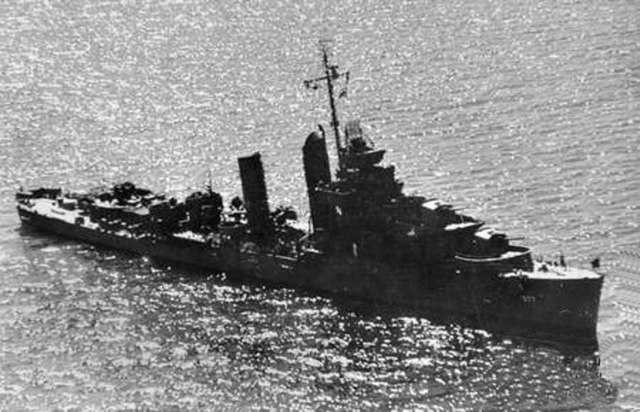 United KingdomPhoto: HMS Ulster Queen, 8 June 1943 United KingdomPhoto: HMS Ulster Queen, 8 June 1943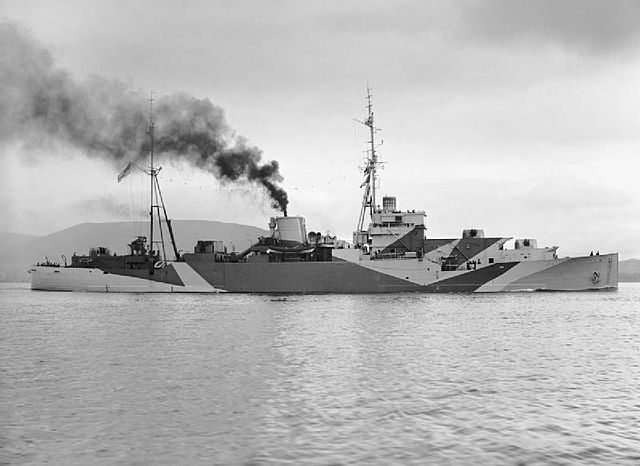 Pacific War Pacific WarALEUTIAN ISLANDS CAMPAIGN (Eleventh Air Force) A C-47 is the first USAAF airplane to land on Attu, landing fighters crews at Alexai Point. All other flying is cancelled due to weather. Naval Air Facility, Attu, Aleutians, is established. CHINA (Fourteenth Air Force) In French Indochina, 7 B-24's and 6 B-25's, with P-40 escorts, are dispatched to bomb shipping and dock installations at Haiphong. Bad weather prevents striking the primary targets; alternates, including Hongay shipping, rail yard, and power facilities, Gia Lam Airfield, and warehouses E of Hanoi are bombed. P-40's bomb and strafe Japanese HQ at Tatung, China barracks E of Lamaing, Burma on the Salween River, and a camp N of Lungling, China. SOUTH PACIFIC THEATER OF OPERATIONS (Thirteenth Air Force) B-24's on armed reconnaissance bomb Kahili Airfield and Ballale. SOUTHWEST PACIFIC THEATER OF OPERATIONS (Fifth Air Force) B-25's bomb Koepang and hit the area SE of Dili. B-24's unsuccessfully attack shipping at Waingapoe, in the Sunda Islands and off Wewak. JAPAN Ammunition in the magazine on the Japanese battleship Mutsu, exploded during extremely hot weather, while the ship was anchored in the harbor at Hashirajima, killing 1,222 people including 1,121 of the 1,474 member crew. PACIFIC Submarine Finback (SS-230) attacks Japanese convoy, sinking auxiliary minelayer Kahoku Maru about 100 miles north of Palau, 08°14'N, 134°18'E.
|
|
lordroel
Administrator
Posts: 68,086 
Likes: 49,473
|
Post by lordroel on Jun 9, 2022 2:48:29 GMT
Day 1366 of World War II, June 9th 1943Eastern Front German and Russian forces on the eastern front launched a series of probes against each other. Soviet thrusts along the Mius River gained some ground while a German attack near Lisichansk did not. Air War over Europe RAF No. 350 (Belgian) squadron moves to Ouston Airfield. 8 OTU Wellingtons went on leaflet flights to France. 1 aircraft crashed in England. Battle of the MediterraneanThe heavy shelling of Pantelleria Island continued for the sixth straight day, dropping more than 822 tons and the Allies say that it will go on until the island surrenders. Medium and heavy bombers, and fighters of the Northwest African Strategic Air Force (NASAF) continued pounding the Island in predawn hours and during the afternoon. German occupied YugoslaviaThe Axis “Operation Black” against the Yugoslavian partisans succeeded in trapping Tito and a battalion of his troops. A breakout was made which left 100 partisans dead, Tito was wounded during a German air attack and his forces scattered. However, they regrouped and fought on. In Sicily, B-24s bombed the landing ground at Gerbini and the airfield at Catania. United KingdomPhoto: Airborne soldiers retrieve folding motorcycles or 'Welbikes' from equipment containers, Bulford, 9 June 1943 Pacific War Pacific War CHINA (Fourteenth Air Force) 6 P-4O's damage a railroad bridge at Puchi, China and strafe nearby railroad yards. SOUTH PACIFIC THEATER OF OPERATIONS (Thirteenth Air Force) In the Solomon Islands, B-24's on reconnaissance attack a small vessel WNW of Cape Henpan. B-17's, P-40's, and P-38's' pound the airfields at Munda and Vila. SOUTHWEST PACIFIC THEATER OF OPERATIONS (Fifth Air Force) In New Guinea, 2 B-24's bomb the town area of Manokwari and Nabire Airfield. A lone B-17 bombs Unea Island in the Bismarck Archipelago. PACIFIC Submarine Greenling (SS-213) damages Japanese oiler Akebono Maru en route to Truk, 02°17'N, 145°38'E.
|
|
lordroel
Administrator
Posts: 68,086 
Likes: 49,473
|
Post by lordroel on Jun 10, 2022 7:21:03 GMT
Day 1367 of World War II, June 10th 1943Eastern Front 700 Russian night bombers attacked German positions at Yaroslavl and airfields west of Kursk; 19 were lost. Air War over Europe HQ US 386th Bombardment Group (Medium) and it's 552d, 553d, 554th and 555th Bombardment Squadrons (Medium) with B-26s transferred from Snetterton Heath, England to Boxted, England. The group will fly it's first combat mission on 30 Jul 43. The detachments of the US 416th Night Fighter Squadron, VIII Fighter Command at Cranfield, Usworth, and Bath, England returned to their base at Honiley, England. The squadron was attached to the RAF for training on Beaufighters. The Combined Chiefs of Staff (CCS) issued a directive through the Chief of Air Staff (C/AS), Royal Air Force (RAF), marking the official beginning of the Combined Bomber Offensive (CBO) of the USAAF and RAF against sources of German war power. The 'Pointblank Directive' outlined the priorities and aims of the bomber offensive leading up to the cross channel invasion of France. The RAF was to bomb strategic city areas at night and the USAAF was to hit precise targets by daylight. However, the primary focus when weather permits was to attack targets identified at the Casablanca conference. German fighter force and related industry are a high priority because of the American intention to begin daylight bombing. The CCS sanctions the Combined Operational Planning Committee as the agency for coordinating the efforts of the CBO forces. However, the plan was not specific enough and this allowed both the US Air Force and British Bomber Command to conduct their independent operations as they saw fit. 5 Whitleys and 1 Wellington went on leaflet raids to France. 1 Whitley was lost. The operations since the end of May were a good example of the way in which Bomber Command curtailed its operations during the moon period. Battle of the Atlantic U.S. tanker Esso Gettysburg, en route from Port Arthur, Texas, to Philadelphia, Pennsylvania, is torpedoed and sunk by German submarine U-66 at 31°02'N, 79°15'E; intense fires, fed by the ship's cargo of crude oil, prevent boats from being launched; only seven of the 27-man Armed Guard and eight of the 45-man merchant complement survive the inferno that consumes the ship. For his heroism in ordering the forward gun manned and opening fire on the attacking U-boat, Ensign John S. Arnold, II, USNR, commanding the Armed Guard, will receive the Navy Cross. Steamship George Washington rescues the few survivors. Battle of the MediterraneanPantelleria was bombed for the seventh straight day and reached a crescendo. Following attacks during the night by fighter-bombers, Northwest African Strategic Air Force (NASAF) and Northwest Tactical Air Force (NATAF) aircraft (fighters, and light, medium and heavy bombers)maintained all-day attacks on Pantelleria Island. Over 1,000 sorties were flown. B-25s, escorted by fighters, bombed the Island. The escorting fighters dive-bombed targets on the island. Sicily-based enemy aircraft appeared but failed to impede the Allied air offensive. 1,571 tons of bombs were released. It was one of the heaviest air attacks of the war up to that time. The Army Air Forces official history described how; "wave after wave of bombers swept over former Tunisian battlefields and out across the Mediterranean." It went on to note that observers were "struck by the power of the aerial weapon which the Allies had forged."More than 100,000 leaflets were dropped on the island demanding its unconditional surrender. "The demand was made to save the garrison from unnecessary suffering", said Allied headquarters. "Pantelleria will continue to be subjected to bombing and blockade."With the failure of the second surrender call to meet with a response, the British 1st Infantry Division embarked on the night of June 10-11 to assault and capture Pantelleria. Royal Air Force (RAF) heavy bombers attacked Reggio di Calabria Airfield, Italy. The partisan leader Josip Broz, better known by his nom de guerre, Tito, narrowly escaped capture when his temporary headquarters in a Bosnian farmhouse were surrounded by Axis soldiers, it was revealed today. Tito heard a warning shout, leapt through a window and spent the next few hours hiding in a ditch listening to the Italian troops in the house. Several of Tito's staff were captured and executed later. The informer can expect little mercy from Tito's men. With a price of 100,000 Reichsmarks (£8,300) on his head, Tito is the most wanted man in Europe and has had several similar escapes. GermanyThe possibility of an Allied invasion of Sicily was discounted in the projections of German High Command (OKW). United States Photo: The U.S. Navy destroyer USS Earle (DD-635) underway with the crew at quarters for either leaving or entering port on 10 June 1943. This photograph was retouched by wartime censors to remove radar antennas atop her foremast and Mark 37 gun director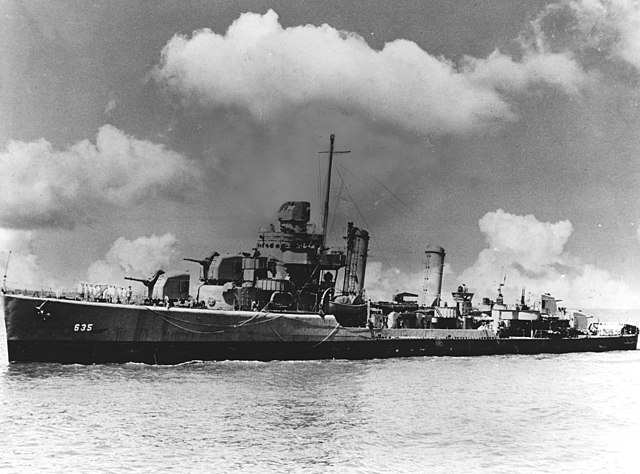 Photo: The U.S. Navy destroyer USS Bell (DD-587) off the Charleston Navy Yard, South Carolina (USA), on 11 June 1943 Photo: The U.S. Navy destroyer USS Bell (DD-587) off the Charleston Navy Yard, South Carolina (USA), on 11 June 1943 Photo: The U.S. Navy seaplane tender USS Albemarle (AV-5) underway at sea on 10 June 1943. She is painted in Camouflage Measure 12 (Modified). Note the Vought OS2U Kingfishers aft Photo: The U.S. Navy seaplane tender USS Albemarle (AV-5) underway at sea on 10 June 1943. She is painted in Camouflage Measure 12 (Modified). Note the Vought OS2U Kingfishers aft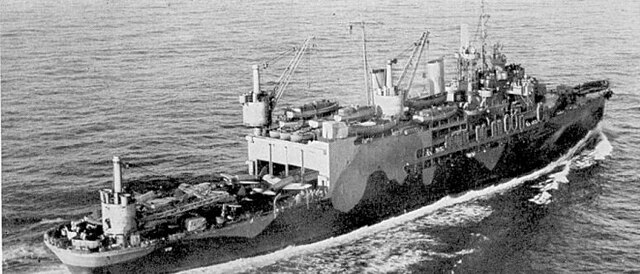 Photo: Flight deck crewmen spring into action after a U.S. Navy North American SNJ Texan traps on board the training aircraft carrier USS Sable (IX-81) operating on Lake Michigan (USA). The crewmen removed the aircraft's tailhook from the arresting wires and prepared it for launch as Sable had no room to park aircraft, June 10th 1943 Photo: Flight deck crewmen spring into action after a U.S. Navy North American SNJ Texan traps on board the training aircraft carrier USS Sable (IX-81) operating on Lake Michigan (USA). The crewmen removed the aircraft's tailhook from the arresting wires and prepared it for launch as Sable had no room to park aircraft, June 10th 1943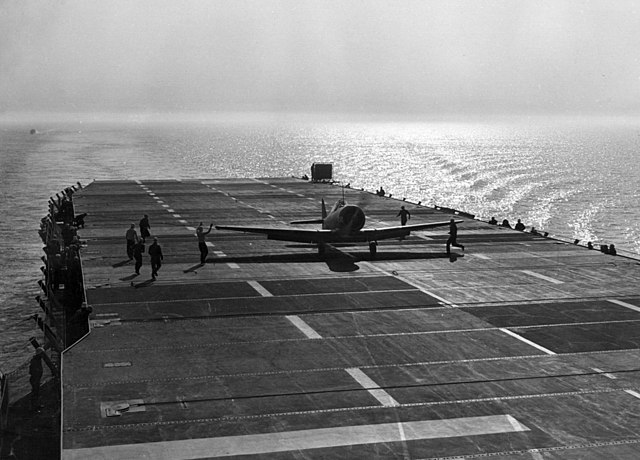 Pacific War Pacific WarALEUTIAN ISLANDS CAMPAIGN (Eleventh Air Force) In the Aleutian Islands, 7 B-24's, 8 B-25's, 12 P-40's, and 2 F-5A's fly weather reconnaissance, attack, and photo missions to Kiska Island and Little Kiska Island. Targets include gun batteries, runway, North Head and Main Camp. CHINA (Fourteenth Air Force) In China, 9 P-40's on armed reconnaissance strafe 10 barges and a gunboat at Chienli; 1 barge is set aflame. 10 P-40's intercept about 25 airplanes over Hengyang; 1 enemy bomber is shot down. SOUTH PACIFIC THEATER OF OPERATIONS (Thirteenth Air Force) In the Solomon Islands, P-38's and Navy fighters claim 4 aircraft downed off the N tip of Malaita Island. B-17's and B-24's pound the airfield at Kahili twice during the day. SOUTHWEST PACIFIC THEATER OF OPERATIONS (Fifth Air Force) More than 20 B-17's and B-24's pound airfields in the Rabaul, New Britain Island area. A single B-24 bombs the town of Sorong and shipping at Kokas. PACIFIC Submarine chaser PC-487 is damaged when she intentionally rams and sinks Japanese submarine I-24 40 miles north-northeast of Shemya Island, Aleutians, 53°16'N, 174°24'E. Submarine Flying Fish (SS-229) unsuccessfully attacks Japanese cargo vessel Fujikawa Maru, 24°55'N, 145°36'E. Submarine S-30 (SS-135) sinks Japanese merchant cargo ship Jimbu Maru, 50°23'N, 155°36'E. Submarine Tinosa (SS-283) damages Japanese oiler Iro 30 miles off Fuka Island, Kyushu, 31°14'N, 132°44'E. Although damaged in return by depth charges during enemy counterattacks, the submarine remains on patrol. Submarine Trigger (SS-237) damages Japanese carrier Hiyo 18 miles off Irozaki, 34°13'N, 139°50'E. Japanese river gunboat Atami is damaged by Chinese aircraft near Tung Ting Lake, China.
|
|
lordroel
Administrator
Posts: 68,086 
Likes: 49,473
|
Post by lordroel on Jun 11, 2022 13:53:05 GMT
Day 1368 of World War II, June 11th 1943YouTube (Eisenhower Lays Out His Plans for Sicily)Air War over Europe The USAAF's VIII Bomber Command in England flew Mission Number 62: 252 B-17s were dispatched against the U-boat yard at Wilhelmshaven, Germany and the port area at Cuxhaven, Germany. 218 hit the targets and claimed 85 Luftwaffe aircraft. Eight B-17s were lost. The raid on Wilhelmshaven demonstrated the difficulty of operating beyond range of fighters escort as enemy fighter attacks prevented accurate bombing of the target. 326 Lancasters, 202 Halifaxes, 143 Wellingtons, 99 Stirlings and 13 Mosquitoes attacked Dusseldorf. 38 aircraft were lost. This was the first night that more than 200 Halifaxes took part in a raid.The Pathfinder marking plan proceeded excellently until an Oboe Mosquito inadvertently released a load of target indicators 14 miles north-east of Dusseldorf. This caused part of the Main Force to waste its bombs on open country. But the main bombing caused extensive damage in the center of Dusseldorf where 130 acres were claimed as destroyed and this proved to be the most damaging raid of the war for this city. Dusseldorf reported that the fire area measured 8 km by 5 km covering the city center - both the old and the new parts, the Derendorf district and the south of the city. No less than 8,882 separate fire incidents were recorded of which 1,444 were classified as large. 1,292 people were killed and 140,000 people were bombed out of their homes. The list of destroyed and seriously damaged industrial and public buildings covered 4 typed pages in the Dusseldorf report. 42 industries connected with the war effort suffered complete stoppages of production and 35 more suffered a partial reduction. 20 military establishments were hit. 8 ships were sunk or damaged. The Gau (province) local government headquarters was destroyed. 29 Lancasters, 22 Halifaxes and 21 Stirlings were dispatched on an interesting raid on Munster. All the aircraft were provided by 8 Group and it was really a mass H2S trial. 33 of the aircraft carried markers or flares, the remaining aircraft acting as the bombing force although the marker aircraft also bombed. The marking and bombing were very accurate and the whole raid lasted less than 10 minutes. Photographic reconnaissance showed that much damage was done to railway installations in Munster as well as to housing areas. Munster's report was very brief stating only that 132 buildings were destroyed, 317 were seriously damaged and 52 people were killed. Unfortunately the raid was expensive for the small force involved. 5 aircraft were lost. Major Hermann Graf arrived at Wiesbaden-Erbenheim airfield to begin forming a new high-altitude fighter Geschwader for Reichmarschall Goering's anti-Mosquito group. Major Graf, who was directly responsible to Goering, had very little problem arranging the transfer of a number pilots to his group. The fighter unit started with 8 specially modified Bf 109Gs though the arrival of the planes and pilots was delayed. The Bf 109Gs were equipped with a special tank for a Nitro-Oxide mixture contained under pressure in liquid form and injected directly into the supercharger intake to cool the engine temperature and increase performance. The unit was named Jagdgruppe Sud. HQ US 388th Bombardment Group (Heavy) and it's 560th, 561st, 562d and 563d Bombardment Squadrons (Heavy) arrived at Knettishall, England from the US with B-17s. The group will fly it's first combat mission on 17 Jul 43. HQ US 389th Bombardment Group (Heavy) and it's 564th Bombardment Squadron (Heavy) arrived at Hethel, England from the US with B-24s. The group will fly it's first mission on 9 Jul. A Ju 88A-6 belonging to 12./KG 30 crashed at Fliegerhorst Aalborg West due to pilot error and was 80% damaged. Obergefreiter Adriano Puzzilli and Gefreiter Duino Vanzini died and were brought to Frederikshavn from Lazarett Aalborg and were laid to rest in Frederikshavn cemetery on 16 June 1943. Battle of the MediterraneanThe Allies launched “Operation Corkscrew”, a landing on the bomb range formally known as Pantelleria Island. As the British 1st Infantry Division landing craft headed toward the island, B-17s delivered a final pounding to the Pantelleria harbor area. During the next 12 minutes, the Fortresses dropped tons of bombs, resulting in "simultaneous flashes and a great roar," stated the AAF official history. "Suddenly the whole harbor area appeared to rise and hang in midair, while smoke and dust billowed high, dwarfing Montagna Grande, Pantelleria's tallest peak." YouTube (Allied forces attack the islands of Pantelleria and Lampedusa - 1943)At about 11:00 hours, Allied airplanes spotted a white cross on the airfield. Shortly thereafter, the first British assault wave hit the beach. The commander of the landing force contacted Pantelleria's military governor, Vice Adm. Gino Pavesi, who surrendered the island and the garrison of 78 Germans and 11,121 Italians. A small number of captured German technicians maintained that German soldiers and anti-aircraft gunners would have made a much better showing than the island's garrison. On the other hand, the sheer intensity of bombing and its increasing weight, according to the testimony of prisoners of war, made it doubtful that the outcome would have been different. Although more than 5000 tons of bombs were dropped on the island, there was less damage than expected. The harbor facilities at Pantelleria had been badly damaged; the town itself had been practically destroyed; communications were a shambles; roads had been obliterated; electric power had been destroyed; and water mains were broken. At Marghana airdrome, the airfield was cratered. Although the underground hangar had withstood a number of direct hits, except for two aircraft, all of the 80-plus enemy airplanes had been either destroyed or damaged. The 1943 Pantellerian experience pointed the way toward the Allies' future strategy: Intensive air bombardment, increasing in tempo, and naval bombardment would precede landing operations. As the AAF official history noted: "The pattern set here was probably one that would be followed in other island operations and perhaps in the invasion of the continent itself." The Allies now intensified preparations for the assault on Sicily in July 1943. Allied airplanes operating from Pantelleria would play a critical role in that assault operation. Photo: The U.S. Navy amphibious force command ship USS Ancon (AGC-4) on 11 June 1943 during preparations for the invasion of Sicily Photo: Bombs bursting on the docks and harbour of Pantelleria, as seen from on board the cruiser HMS ORION, in preparation for the allied invasion of the island in 1943 Photo: Bombs bursting on the docks and harbour of Pantelleria, as seen from on board the cruiser HMS ORION, in preparation for the allied invasion of the island in 1943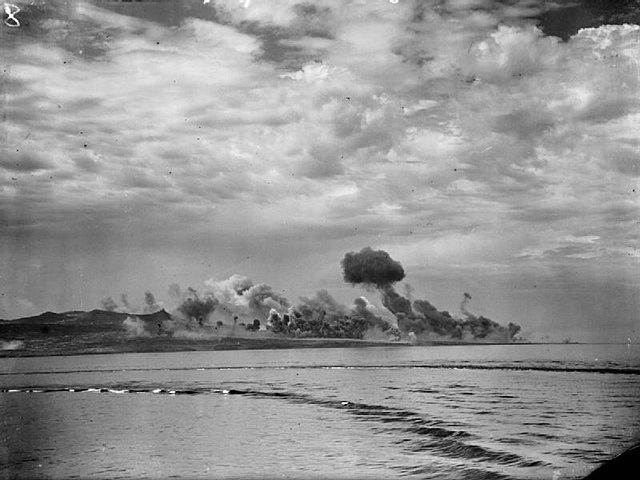 Photo: Pantelleria and Lampedusa May - June 1943: Men of 1st Battalion, The Duke of Wellington's Regiment, advance past a burning fuel store on Pantelleria. Left to right: Lance Sergeant A Haywood, Private C Norman and Private H Maw Photo: Pantelleria and Lampedusa May - June 1943: Men of 1st Battalion, The Duke of Wellington's Regiment, advance past a burning fuel store on Pantelleria. Left to right: Lance Sergeant A Haywood, Private C Norman and Private H Maw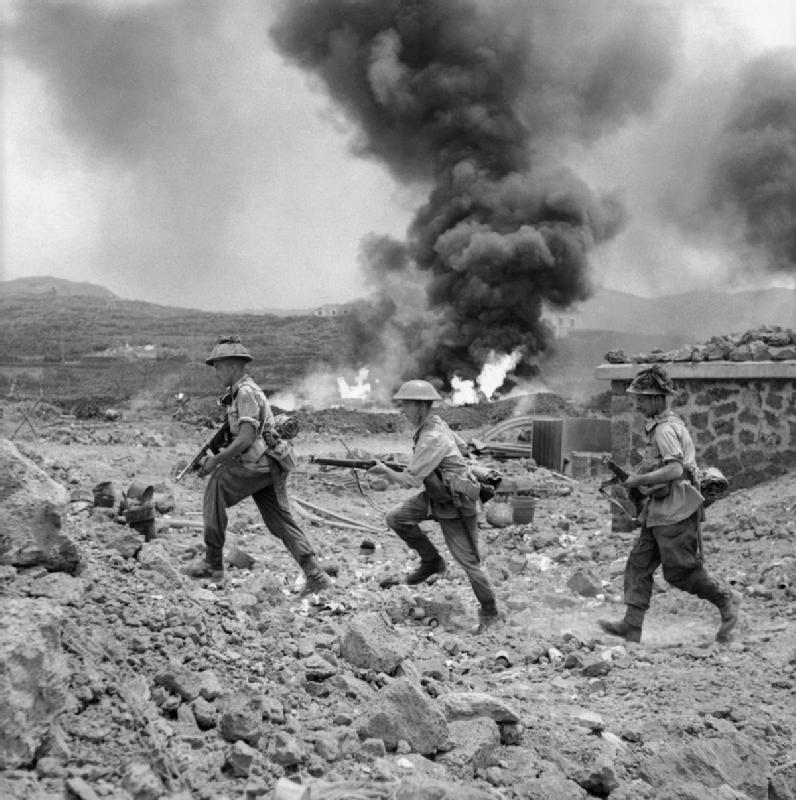 United Kingdom United Kingdom
Photo: HMS Blackbird, a British Isles-class Trawler. 11 June 1943 Pacific War Pacific WarALEUTIAN ISLANDS CAMPAIGN (Eleventh Air Force) In the Aleutian Islands, 7 B-24's, 8 B-25's, 10 P-40's, 4 P-38's, and 2 F-5A's fly weather, photo, reconnaissance, and attack missions to Kiska Island. Main targets are Gertrude Cove and Main Camp, South Head, North Head, runway, and offshore barges. Fighter bombing and strafing, and subsequent bomber runs over emplacements, are effectively coordinated. CHINA (Fourteenth Air Force) Eight P-40's hit a camp on the Salween River, trucks at Mangshih, and warehouses at Tungling, China. SOUTHWEST PACIFIC THEATER OF OPERATIONS (Fifth Air Force) B-24's again bomb the airfield at Rabaul and hit targets of opportunity at Gasmata and along the shore of Keravia Bay. In New Guinea, B-25's pound areas along Huon Gulf coast, hitting Kela Point, Salamaua and the bridge at Nuk Nuk. P-40's strafe a submarine off Cape Nelson. In Timor, Koepang is thoroughly blasted by B-24's while Penfoei and Dili airfields are hit by light B-25 attacks. The 432d Fighter Squadron, 475th Fighter Group transfers with P-38's from Charters Towers, Australia to Amberley Field, Townsville, Australia. Lost is B-24D "Care Less" 42-40500. PACIFIC Submarine Finback (SS-230) attacks Palau-bound convoy just west of Babelthuap, sinking Japanese army cargo ship Genoa Maru, 07°36'N, 134°17'E. Patrol Boat No.46's counterattack fails to inflict damage, and Finback escapes undamaged. Submarine Runner (SS-275) sinks Japanese merchant cargo ship Seinan Maru off Monomi Zaki, off northwest coast of Honshu, 41°00'N, 141°30'E. Submarine S-30 (SS-135) sinks Japanese merchant cargo vessel Jimbu Maru, anchored in Kakumabetsu Wan, Paramushiro, Kuriles, 50°23'N, 155°36'E. Submarine Silversides (SS-236) attacks Japanese convoy about 270 miles south of Truk, sinking transport Hinode Maru north of New Ireland, 02°43'N, 152°00'E.
|
|
lordroel
Administrator
Posts: 68,086 
Likes: 49,473
|
Post by lordroel on Jun 12, 2022 3:42:26 GMT
Day 1369 of World War II, June 12th 1943Air War over Europe A British Coastal Command Mosquito plane flew a reconnaissance flight over Peenemünde, Germany. Photos showed a large rocket lying on a trailer. The rocket was a V-2, the type first used in September 1944. 323 Lancasters, 167 Halifaxes and 11 Mosquitoes attacked Bochum, 24 aircraft lost. This raid took place over a completely cloud-covered target but accurate Oboe sky-marking enabled the all Lancaster/Halifax Main Force to cause severe damage to the centre of Bochum. After daylight photographs had been taken, 130 acres of destruction were claimed. The only report from Germany said that 449 buildings were destroyed and 916 severely damaged and that 312 people were killed. On the first operational mission of a He 219A 'Uhu' night-fighter, flown by Major Streib of I./NJG 1 and Uffz. Fischer as his radioman, the 'Uhu' shot down 5 RAF heavy bombers on the raid to Bochum. On returning to base, Major Dtreib misjudged the runway because of dim lights and crashed. The Heinkel hit the ground so hard that ir broke up but both men walked away without a scratch. Upon hearing about Major Streib's success with the He 219, Generalluftzugmeister Milch replied, "....perhaps Streib would have shot down just as many had he been flying another type of aircraft."In the next 10 days, the He 219 would redeem itself by claiming 20 RAF bombers and 6 previously untouchable Mosquitoes. 34 Wellingtons went to the Frisians , Lorient and St Nazaire minelaying without loss. At approximately 09:30 hours a Ju 88A-4 belonging to 11./KG 30 hit the ground near Mørke and burst into flames and was a 100% loss. All four flyers were laid to rest in Frederikshavn cemetery on 16 June 1943. Another Ju 88A-4 belonging to 12./KG 30 crashed at Fliegerhorst Aalborg West due to pilot error and was 60% damaged. The crew were unharmed. A Ju 88C-6 belonging to 11./NJG 3 was on a calibration flight for radar. Lt. Nicolas Volkmar tried to reach base when the left engine lost power. Ammunition and machine guns were dumped overboard to lighten the aircraft but Lt. Volkmar could not keep it flying and touched down on a hill where there was a potato field. From the hill, the Ju 88C-6 skidded into a meadow where there were stumps that had not been removed. These ripped the bottom of the Ju 88 and it came to a halt a few metres from two bulls that were hitched in the meadow. The aircraft was 75% damaged. A truck arrived with a team of guards that guarded the aircraft, and took the crew back to Grove. In the morning a new team of guards arrived to release those who had been on duty during the night. The team was billeted at the farm for about five days while a team of 6-8 men took the Ju 88 apart and transported it back to Fliegerhorst Grove. The local police constable spent the next three days collecting the guns and ammunition dumped from the aircraft. It was found on a three kilometres long trail west of the landing ground. Afterwards the farmer received 600 kroner as compensation for the damage to his field. Probably due to a mistake he received yet another check of 600 kroner about a year later. This check was cashed in a hurry. 3(F)./122 sent out a Ju 88 from Schiphol, tasked with a recon of a convoy off the east coast of England. The Ju 88 was attacked by a Beaufighter and crash-landed off the Dutch coast. Two crewmen were wounded and taken to hospital. The Beaufighter was crewed by F/O J. N. Howard-Williams and F/O J. A. Quinton of RAF No. 604 Sqdrn. As the Ju 88 did not make it back to base, it was not suitable for the 2000th Feindflug of the German unit, the offical 2000th taking place 3 days later. Battle of the Atlantic Aircraft (VC 9) from escort carrier Bogue (CVE-9) sink German submarine U-118, mid-Atlantic area, 30°49'N, 33°49'W. Submarine R-12 (SS-89) sinks, cause unknown, off Key West, Florida, 24°24.30'N, 81°38.30'W. Battle of the MediterraneanFighters, light, medium and heavy bombers of the Northwest African Strategic Air Force, the Northwest African Tactical Air Force and the USAAF Ninth Air Force hit Lampedusa Island in the Strait of Sicily. Twenty four B-25s (12 of the 445th) took off at 13:39 to bomb the town and adjacent area of Lampedusa. The escort were 12 P-38s from the 82nd fighter group. A string of bombs fell through the town, harbor installations, radio building and small boats on shore. A couple gun emplacements were hit. The island was secured without resistance in Operation Corkscrew by the Royal Navy destroyer HMS Lookout and ninety-five men of the 2nd Battalion the Coldstream Guards. White flags had been sighted in the port, and when Lieutenant Corbett of Lookout approached the port in a motor launch, he was told that the island's garrison wished to surrender. Mussolini had given the garrison his permission to surrender because it lacked any water. The Governor's formal surrender was accepted in the island's underground command-post by a combined Army/Navy delegation sometime before 9:00 pm. During this process, the governor handed his sword to the Coldstream company commander, Major Bill Harris. The unescorted 'Palima' was hit by one torpedo from 'U-97' and sank rapidly. 24 crewmembers and two British gunners were lost. 37 crewmembers and two British gunners rescued themselves on a few rafts that had floated free. During the day they were spotted by an aircraft, picked up by a large whaleboat and a Greek destroyer and landed at Beirut the same day. In Sicily, B-17s and B-26s bombed Castelvetrano, Boccadifalco, and Milo Airfields. Battle of the Indian Ocean British destroyer HMS Relentless rescues last survivors from U.S. tanker William King, torpedoed and sunk by German submarine U-198 off the South African coast on 6 June 1943. North AfricaKing George VI of Great Britain arrived in North Africa to visits the troops. He will go to Malta on the 20th. United States Photo: Launching of the U.S. Navy destroyer escort USS Leopold (DE-319) at the Consolidated Steel Corporation shipyard, Orange, Texas (USA), on 12 June 1943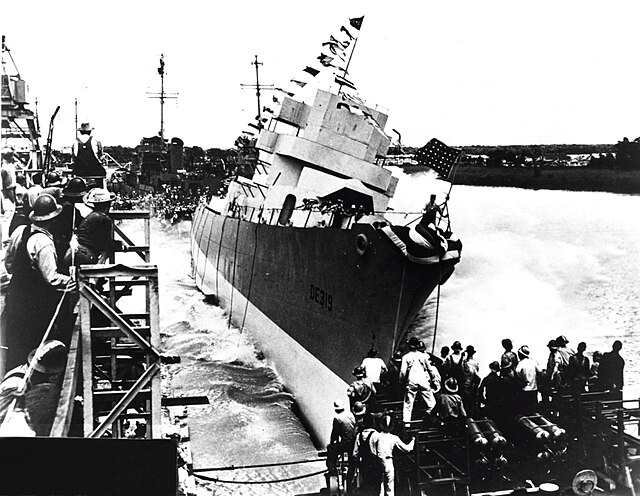 United Kingdom Photo: HMS Diomede at anchor, 12 June 1943 United Kingdom Photo: HMS Diomede at anchor, 12 June 1943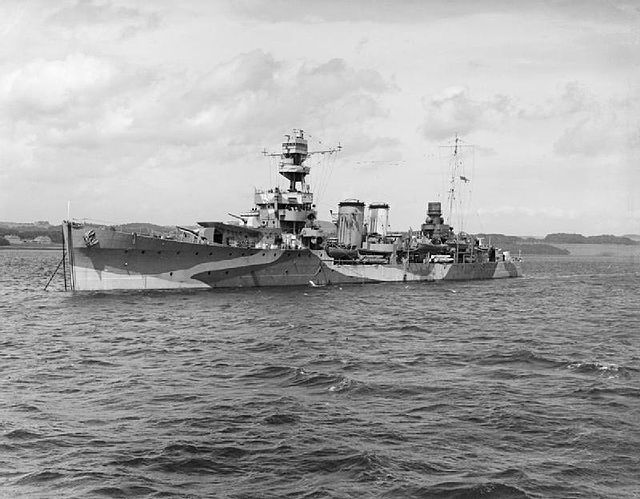 Pacific War Pacific WarALEUTIAN ISLANDS CAMPAIGN (Eleventh Air Force) A detachment of the 344th Fighter Squadron, 343d Fighter Group based at Ft Glenn, Alaska begins operating from Attu Airfield with P-40's SOUTH PACIFIC THEATER OF OPERATIONS (Thirteenth Air Force) USAAF fighters, along with Royal New Zealand Air Force (RNZAF), US Navy, and US Marine Corps fighters, claim over 30 aircraft shot down during the interception of an enemy strike on Guadalcanal Island, Solomon Islands. 8 Allied fighters are lost, including four F4Fs, one F4U and one RNZAF P-40 (pilot KIA). Two B-24s on reconnaissance over Buka shoot down a G4M1 Betty. SOUTHWEST PACIFIC THEATER OF OPERATIONS (Fifth Air Force) B-24's hit runways at Nabire and Kaimana; a lone B-25 bombs and strafes barges S of Langemak Bay. Dick Bong gets his 11th kill when he downs an Oscar. JAPANESE OCCUPIED PHILIPPINES Submarine Trout (SS-202) lands men and supplies on Mindanao.
|
|
lordroel
Administrator
Posts: 68,086 
Likes: 49,473
|
Post by lordroel on Jun 13, 2022 2:46:58 GMT
Day 1370 of World War II, June 13th 1943Air War over Europe US VIII Bomber Command Mission Number 63: 151 B-17s were dispatched against the Bremen, Germany U-boat yards and a smaller force of 76 B-17s were dispatched against the Kiel, Germany U-boat yards. Both forces were unescorted and short-range P-47s were used on 2 diversionary sweeps off the coast during the morning and afternoon. The Thunderbolts from the US 56th FG met with the Fw 190s of III./JG 26 off the Belgian coast in the morning sweep. 2 Fw 190s were claimed by Col. Hub Zemke although only Ogfr. Heinrich Zenker was shot down and killed and Oblt. Karl-Heinz Bocher was wounded. The second sweep in the afternoon found 44 P-47s from the US 78th FG clashing with the Fw 190s of II./JG 26. 2 P-47s were shot down without loss to the Gruppe. 3 P-47s were claimed by pilots of JG 26, claimants including Ofw, Heinz Gomann and Lt. Friedrich Lange - both from 5./JG 26 - and Fw. Hans Mayer of 6./JG 26. Meanwhile the B-17s continued on to their targets, hoping that the two-pronged attack would split the defending fighters. The Bremen formation was attacked by 6./JG 11 and 32 Bf 109s and Fw 190s of III./JG 26 led by Gruppenkommandeur Hptm. Kurt Ruppert. A massive diving frontal attack raked the lead B-17 with cannon fire and it fell out and spiraled down. On board was Brigadier General Nathan Bedford Forrest III of HQ 402d PCBW, riding in the co-pilots seat. All 13 crewmen bailed out but only one, the group navigator survived. General Forrest was the first American General to be lost in combat in Europe. The body of General Forrest was found near the seaplane base at Bug on Rügen and was laid to rest in Wiek cemetery on 28 September 1943. In 1947 his body was moved to Arlington cemetery, USA. (B 17F 42-30164 crashed Kiel Bay 13/6-1943) A second massive sweep through the formations from the rear immediately destroyed 4 more B-17s from the US 95th BG. On this pass, Hptm. Ruppert was hit by return fire and forced to bail out. He tried to open his parachute too quickly and it ripped his hemp harness and he fell to his death. 5 more B-17s were shot down bringing a total of 10 lost by the 95th BG in a few minutes of combat. In what the USAAF says was one on the heaviest fighter attacks to date, 26 B-17s were lost. A B-17F belonging to the 95 BG, 336 BS which was christened “Rat Killer”, was one of those shot down, crashing in the sea south of the island of Langeland. 3 more B-17s crashed in Kiel Bay. 31 B-17s were claimed by pilots from JG 1, JG 11, JG 26, JG 54 and NJG 3. 6 Mosquitoes went to Berlin, 4 to Dusseldorf and 3 to Cologne, no losses. All targets were cloud covered and only estimated positions were bombed. German raiders dropped "butterfly" anti-personnel bombs for the first time, killing 74 people and injuring 130. At about 11.30 hours, a Typhoon operating from Milfield airfield, near Wooler, crashed in a field at Kimmerston Farm, Milfield. The plane was heard to come down in a power dive at a speed estimated at 600 mph, it did not pull out of it in time. The pilot was killed. Night fighter ace Wing Commander John Cunningham, brought down his 16th victim over southern England. 18 Wellingtons and 12 Stirlings went minelaying off the Biscay ports. 1 Wellington was lost. Battle of the Atlantic The United States Coast Guard Cutter 'ESCANABA' (PG-77), was sunk by a German submarine torpedo, off Ivigtut, Greenland. Battle of the MediterraneanIn Sicily, US and Royal Air Force (RAF) heavy bombers attacked Catania and Gerbini Airfields, causing severe damage to aircraft, runways, hangars, and other installations. The heavy bombers claimed 5 fighters but 2 B-24s were shot down at sea. The Italian island of Linosa in the Sicilian Channel surrendered to the British. United StatesPhoto: The U.S. Navy destroyer USS Abner Read (DD-526) off the Hunters Point Naval Shipyard, California (USA), on 13 June 1943, after repairs in the drydock there Pacific War Pacific WarBURMA-INDIA (Tenth Air Force) In Burma, 9 B-25's attack the Meza railway bridge on the Mandalay- Myitkyina line, causing minor damage. CHINA (Fourteenth Air Force) In China, 11 B-25's supported by 14 P-40's, bomb hangars and the depot area at Nanchang Airfield. SOUTH PACIFIC THEATER OF OPERATIONS (Thirteenth Air Force) B-24's and B-17's again bomb Kahili Airfield. The 371st and 372d Bombardment Squadrons (Heavy), 307th Bombardment Group transfers from Kahuku and Hickam Field, Territory of Hawaii respectively to Espiritu Santo, New Hebrides Islands with B-24's. SOUTHWEST PACIFIC THEATER OF OPERATIONS (Fifth Air Force) B-17's and B-24's bomb airfields in the Rabaul area and at Gasmata. Lost to J1N1 night fighter is B-17F "Georgia Peach" 41-24454. B-25's hit Dili and Koepang and bomb and strafe barges off the Huon Peninsula, at Jacob Island, off Cape Gerhards, and S of Cape Cretin, New Guinea. Single B-24's bomb Lahang Airfield and attack a freighter in Humboldt Bay, both in New Guinea. PACIFIC Destroyer Frazier (DD-607) sinks Japanese submarine I-9 one and a half miles east of Sirius Point, Kiska, Aleutians, 52°08'N, 177°38'E. Submarine Guardfish (SS-217) sinks Japanese army cargo ship Suzuya Maru off the southwest coast of New Ireland, 03°08'S, 151°24'E. Submarine Sargo (SS-188) attacks Japanese convoy 250 miles south of Yap, Carolines, and sinks army transport Konan Maru, 06°08'N, 138°28'E. The submarine is damaged by depth charges, 06°40'N, 136°59'E, but remains on patrol.
|
|
lordroel
Administrator
Posts: 68,086 
Likes: 49,473
|
Post by lordroel on Jun 14, 2022 2:50:13 GMT
Day 1371 of World War II, June 14th 1943
Eastern Front
A German report showed that 100,000 cases of typhus were reported on the Russian front during 1942, with a fatality rate of 15%.
Air War over Europe
197 Lancasters and 6 Mosquitoes attacked Oberhausen, 17 Lancasters lost. This target was cloud covered but once again the Oboe sky-marking was accurate. The report from Oberhausen said that the Germans noted the markers right over the top of the Altstadt. 267 buildings were destroyed and 584 severely damaged. 85 people were killed and 258 were injured.
2 Mosquitoes went to Cologne and 29 aircraft went minelaying off Brittany and in the River Gironde. 1 Stirling minelayer was lost.
The 349th Bombardment Squadron (Heavy), 100th Bombardment Group (Heavy) arrived at Thorpe Abbots, England from the US with B-17s. The squadron would fly it's first mission on 25 Jun.
The creation of the Allied Tactical Air Force in the UK was announced. Following an assessment of 'Exercise Spartan', Tactical Air Forces (TAFs) were created as replacements for RAF Army Co-operation Command. The exercise tested the efficiency of Army co-operation squadrons under mobile conditions, and was effectively a rehearsal for the invasion and liberation of Northwest Europe.
Battle of the Atlantic
RAF Coastal Command began daily patrols over the Bay of Biscay by aircraft equipped with new detection devices to locate and destroy German U-boats leaving and entering their bases on the French coast. 'U-564' (Type VIIC) was sunk at 1730 hrs northwest of Cape Ortegal, Spain by depth charges from a British Whitley aircraft (10 OTU/G).
When an RAF No. 547 Sqdn Wellington attacked 'U-155' in the Bay of Biscay, one man died. [Bootsmaat Heinz Wilke]. Four RAF No. 307 Polish Sqdn Mosquitos then attacked wounding 5 men. 'U-155' shot down one of the Mosquitos. A Mosquito attacked 'U-68' killing 1 and wounding 3 more. 'U-68' later was given the doctor onboard of 'U-155' for some medical treatment.
'U-334' (Type VIIC) was sunk in the North Atlantic southwest of Iceland by depth charges from the British frigate HMS 'Jed' and the sloop 'Pelican'.
Battle of the Mediterranean
During the night Northwest African Strategic Air Force(NASAF) Wellingtons bombed Messina, Italy.
The Italian island of Lampedusa surrendered to the British.
Pacific War
CENTRAL PACIFIC THEATER OF OPERATIONS
(Seventh Air Force) One B-24 from Funafuti Atoll, Ellice Islands bombs the runways at Tarawa Atoll, Gilbert Islands.
CHINA
(Fourteenth Air Force) Eight P-40's intercept about 8 bombers and 20 fighters 25 mi (40 km) SW of Nanchang, China. The P-40's claim 7 fighters shot down.
SOUTH PACIFIC THEATER OF OPERATIONS
(Thirteenth Air Force) 18 B-25's, escorted by F4U's, hit Vila Airfield. 11 B-17's and B-24's bomb Kahili Airfield and hit nearby Shortland.
SOUTHWEST PACIFIC THEATER OF OPERATIONS
(Fifth Air Force) A single B-24 bombs Lakunai Airfield. Lost on a ferry flight is B-17C 'Pamela / Miss E.M.F." 40-2072 with 40 KIA, 1 survivor.
PACIFIC
U.S. freighter William H. Webb is mined while en route from Baltimore, Maryland, to Casablanca, French Morocco, and returns whence she had come for repairs. There are no casualties among the 42-man merchant complement, the sole passenger, and the 30-man Armed Guard.
|
|
lordroel
Administrator
Posts: 68,086 
Likes: 49,473
|
Post by lordroel on Jun 15, 2022 2:49:44 GMT
Day 1372 of World War II, June 15th 1943Eastern Front German General Heinz Guderian told Adolf Hitler that the new Panther tanks were not ready for battle. Air War over Europe 6 Mosquitoes carried out a nuisance raid on Berlin without loss. Additional modifications of YB-40 escort bombers were completed in the United Kingdom. It was now hoped that these B-17s converted to heavily armored aircraft with great firepower would solve the problem of long-range escort for bombers The 565th Bombardment Squadron (Heavy), 389th Bombardment Group (Heavy) arrived at Hethel, England from the US with B-24s. RAF Squadron 101, Radio Counter Measures (RCM), was based at Ludford Magna, near Louth in Lincolnshire, as part of No. 1 Group, Bomber Command. At Ludford a dangerous task was assigned the squadron. Many Allied bombers were falling victim to German night-fighters guided by ground controllers scrutinizing radar screens. An Allied counter-measure named ‘Window’ partially upset this, but the Luftwaffe responded by coordinating the commentaries of several controllers at different locations, and delegating overall command to a single master controller who guided the night-fighters towards the Allied aircraft. The British Telecommunications Research Establishment (TRE) at Malvern developed a response to this that was tested by 101 Squadron. It was called ‘Airborne Cigar’, or ABC, a battlefield version of ‘Ground Cigar’, and its original code name was ‘Jostle’. Using a receiver and three 50-watt T.3160-type transmitters, the German VHF frequency – and language - was identified and then jammed. The jamming caused a loud and constantly varying note running up and down the scale of the relevant speech channel. For this purpose, a German-speaking eighth crew member was included in the crew of especially fitted Lancaster bombers. He was known as the Special Duty Operator, ‘Spec. Op.’, or SO. All were volunteers from various aircrew trades. Since the enemy often gave phoney instructions to divert the jammers, it was essential that they know German reasonably well. In addition, if the Germans changed frequencies the SO would have to be skillful enough to do likewise. The SO had to recognize German codewords – such as Kapelle, for ‘target altitude’ - and log any German transmissions for passing on to Intelligence at the post-flight debriefing. Jewish veteran Flight Sergeant Leslie Temple recalls the Germans trying to distract the SOs by using screaming female voices or martial music. Some sources allege that the SOs were trained in ‘verbal jamming’, that is giving false information in German, but this was very little used. see: Jewish RAF Special Operators in Radio Counter Measures with 101 Squadron Battle of the Atlantic German U-boats hit a convoy in the Atlantic but failed to cause major damage after a running battle of 5-days. Battle of the Baltic Sea MS "T-411" of the Black Sea Fleet and Azov Flotilla was sunk by a U-boat in the Sukhumi area. At 14:19, 'U-24' fired a spread of two torpedoes at the BTShCh-411 'Zashchitnik' (No 26), which had been spotted at 13:54 and observed one hit in the stern after 1 minute 30 seconds. The vessel broke in two and sank about 20 miles west of Suchumi. The survivors were picked up by the Soviet patrol craft SKA-0101 and SKA-0138. Battle of the MediterraneanDuring the night Northwest African Strategic Air Force(NASAF) Wellingtons bombed the airfields at Milo, Sciacca, Castelvetrano, and Boccadifalco, Sicily. B-17s, B-25s, B-26s, and P-38s followed during the morning hours with raids on the same targets and hit the airfield at Bo Rizzo and radio stations near Marsala, Sicily. The US 448th BS took off with 36 planes to bomb the landing ground at Sciacca, Sicily. Hits were made on some planes on ground N of the field and others among barracks S of field. 12 Bf 109s and 6 MA-202s came up from the deck and were attacked by the escorts. The escorts shot down 1 Bf 109. 2 planes were hit by flak and 1 crash landed at Mateur. A detachment of the 12th Reconnaissance Squadron (Fighter), 67th Reconnaissance Group began operating from Malta with F-5s. Submarine HMS 'Umbra' torpedoed and sank the Italian heavy cruiser 'Trento'. 'Trento' was already damaged by a torpedo from an RAF No. 217 Sqn Beaufort from Malta. Submarine HMS 'Ultor' sankthe Italian auxiliary minesweeper 'Tullio'/No.92. A Ju 88D-1 belonging to 2(F)./122 failed to return from a recce to Malta. Suspected engine failure was the cause and Oblt. Heinrich Fennel (observer), Lt Josef Träger and Fw Michael Feiersinger all MIA. At 14:30, the 'Athelmonarch', escorted by the Greek destroyer 'Aetos', was torpedoed and sunk by 'U-97' NW of Jaffa, Palestine. Four crewmembers were lost. The master, 35 crewmembers and eleven gunners were picked up by the destroyer and landed at Beirut. A meeting was held this evening by the 447th BS and the officers and enlisted men asked to vote on whether they would like to contribute more money each month in order to continue to get fresh vegetables and meat. The enlisted men voted to contribute five dollars each for the month of June and the officers voted to contribute ten dollars each. United StatesPresident Roosevelt approved a ceiling of 31,447 useful aircraft for the USN. Photo: USS Octans (AF-26) drydocked in YFD 18 at San Francisco, 15 June 1943. Octans was used to test the new Yard Floating Drydock which was 543’ long and 114’ wide and had a nominal lift of 10,500 tons, 15 June 1943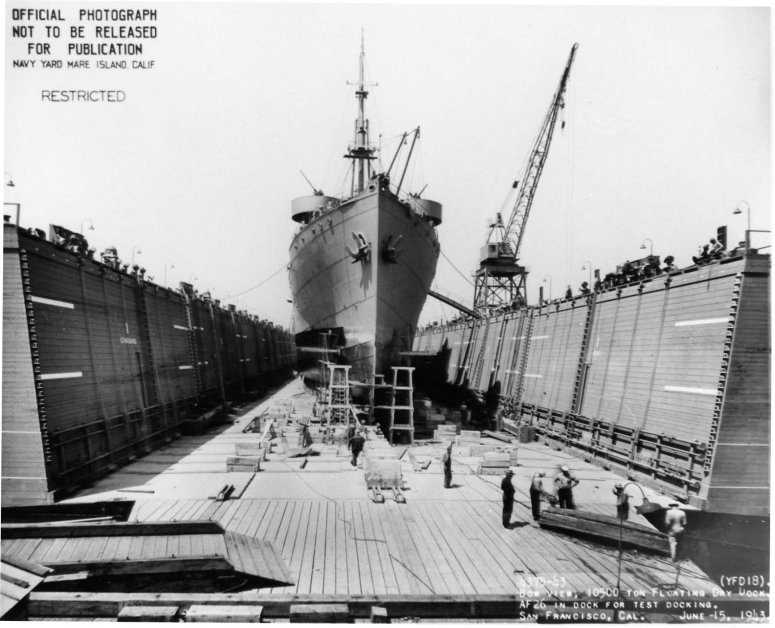 Germany GermanyThe Arado Ar-234, the world's first jet bomber aircraft, had its first test flight at Munster, piloted by Flugkapitän Selle. The Ar 234V-1 had no landing gear so it took off from a 3 wheeled trolley and landed on retractable skids. All went well with the flight but the five braking parachutes failed to open and the landing trolley was destroyed. The Ar 234 was originally concieved in early 1941 by an engineering team under Professor Walter Blume, director of the Arado aircraft company. The design project was code-named 'E-370" and was in response to a German requirement for a fast recon aircraft. Arado projected a speed of 780 kph, an operating altitude of almost 11,000 meters and a maximum range of 2,000 meters. The range was alittle less than the Air Ministry wanted but they liked the design anyway and ordered 2 prototypes. The 2 prototypes, designated Ar 234V-1 and Ar 234V-2 were largely complete before the end of 1941. However the Jumo 004 engines weren't ready and wouldn't be ready for over a year. In February 1943, Arado finally got a pair of Jumo 004As. However, these engines were only cleared for static and taxi tests. At the time, Messerschmitt had priority for engine deliveries for their Me 262 fighter and Arado had to accept what they could. Flight qualified engines were finally delivered that spring and the Ar 234V-1 was flown. Pacific WarBURMA-INDIA (Tenth Air Force) B-25's score 2 direct hits on the bridge at Myitnge, Burma. CHINA (Fourteenth Air Force) Ten B-25's, escorted by 12 P-40's, support Chinese ground forces by bombing positions at Owchihkow, China. SOUTH PACIFIC THEATER OF OPERATIONS (Thirteenth Air Force) B-24's bomb the airfield on Ballale. SOUTHWEST PACIFIC THEATER OF OPERATIONS (Fifth Air Force) B-24's bomb airfields at Rabaul on New Britain Island in predawn strikes and hit Kendari Airfield, Celebes in the evening. In New Guinea, a single B-25 attacks a power boat in Hanisch Harbor and strafes a beach near Finschhafen. PACIFIC Submarine Gunnel (SS-253) sinks Japanese merchant passenger-cargo ship Koyo Maru in Tsushima Straits, 33°55'N, 127°38'E. Submarine Sailfish (SS-192) sinks Japanese merchant cargo ship Shinju Maru south of Todozaki, Honshu, 39°00'N, 142°00'E. Submarine Trout (SS-202) damages Japanese oiler Sanraku Maru in the Celebes Sea, off Sibitu, 05°09'N, 119°38'E; Sanraku Maru is eventually scuttled, 04°45'N, 119°48'E
|
|
lordroel
Administrator
Posts: 68,086 
Likes: 49,473
|
Post by lordroel on Jun 16, 2022 2:50:21 GMT
Day 1373 of World War II, June 16th 1943Air War over EuropeBritish Bomber Command aircraft began dropping sea mines from 6000 feet, instead of 2000-3000 feet. 202 Lancasters and 10 Halifaxes attacked Cologne, 14 Lancasters lost. The marking for this raid was not by Oboe but by 16 heavy bombers of the Pathfinders fitted with H2S. The target was cloud-covered but some of the Pathfinder aircraft had trouble with their H2S sets. The sky-marking was late and sparse and the bombing of the all-Lancaster Main Force was thus scattered. The local report believed that several hundred planes approached Cologne but, because of bad weather, only the first hundred bombed, the remainder turning back. Most of the damage in Cologne was to housing areas; 401 houses were destroyed and nearly 13,000 suffered varying degrees of damage. 16 industrial premises were hit including the Kalk Chemical Works which, according to RAF photographic reconnaissance, was burnt out. Other buildings destroyed or damaged included 9 railway stations, 2 railway stores, 1 telephone exchange, 2 district town halls (at Ehrenfeld and Spanischer Bau), 5 churches, 5 hospitals, 3 cinemas and 2 schools. 147 people were killed and 213 were injured. 5 Mosquitoes went to Berlin. The 566th Bombardment Squadron (Heavy), 389th Bombardment Group (Heavy) arrived at Hethel, England from the US with B-24s. British military intelligence received its first report from an agent about a "bomb with wings" (V-1) being developed in Germany. Battle of the AtlanticCorvette HMCS "Arvida" arrived Iceland for repair of depth charge damage. An aircraft from RAF No. 547 Sqdn attacked 'U-600', killing one crewman. The aircraft was shot down. The first convoys for the Invasion of Sicily, Operation 'Husky', sail from the US. Battle of the MediterraneanWave after wave of Allied bombers flew unmolested over Sicily today, dropping thousands of tons of high explosive on ports, airfields and other military targets. The island was being "softened up" for an invasion - although Rome radio was still talking of Sardinia as a possible target. An announcer described the country's present situation as "the gravest in the whole of her modern history." Four British battleships were on station in Gibraltar, and intensive training was under way both in North Africa and in Scotland, where a beach near Troon was being used for commando "rehearsals", although few knew the actual destination. Two more Italian islands have surrendered. White flags fluttered over tiny Linosa on 13 June as soon as the British destroyer HMS 'Nubian' appeared. Closer to Africa, Lampedusa was pounded heavily from the sea and air before surrendering on 12 June. A British fighter pilot, Sergeant Jack Cohen, force-landed on the island with engine trouble in the middle of the bombardment. Italians came running up to his aircraft waving white flags and shouting: "Can't you stop this?" Cohen was forced to shelter from Allied bombs and shells for two hours. Italian engineers helped him to men his aircraft, and he flew off to tell the navy that Lampedusa was surrendering. The capture of Pantelleria and the other islands has virtually closed the Sicilian narrows to German and Italian shipping. 'U-97' (Type VIIC) was sunk in Mediterranean, west of Haifa by depth charges from an Australian Hudson aircraft (Sqdn 459/T). 27 men died when 'U-97' was lost and 21 men survived. United Kingdom/Portugal relationsBritain invoked the treaty of Windsor (established in 1386, binding Britain and Portugal to mutual assistance), and requested of Portugal that Britain be allowed to use airfields on the Azores islands. United States Photo: Broadside view of the U.S. Navy destroyer esccort USS Fleming (DE-32) immediately after her launching at the Mare Island Naval Shipyard, California (USA), on 16 June 1943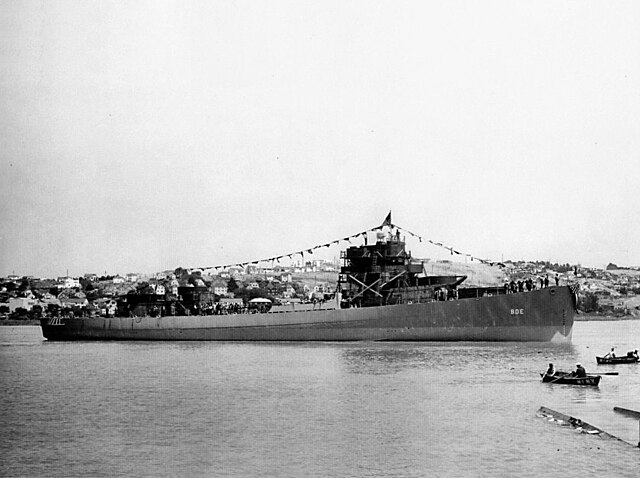 Photo: The U.S. Navy destroyer escort USS McConnell (DE-163) underway on 16 June 1943 Photo: The U.S. Navy destroyer escort USS McConnell (DE-163) underway on 16 June 1943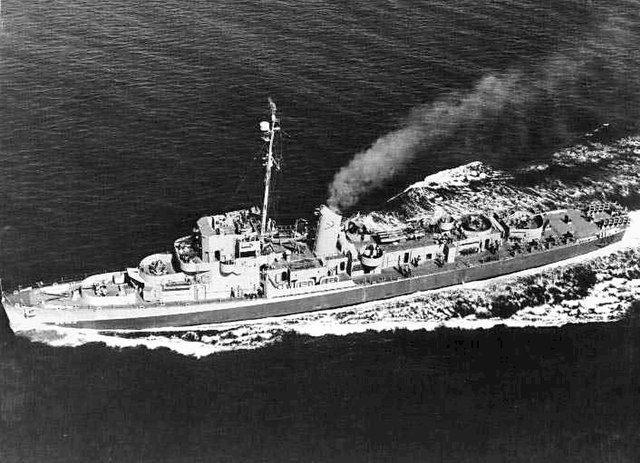 Photo: The U.S. Navy fleet tug USS Navajo (AT-64) underway off San Francisco, Mare Island Navy Yard, 16 June 1943 Photo: The U.S. Navy fleet tug USS Navajo (AT-64) underway off San Francisco, Mare Island Navy Yard, 16 June 1943 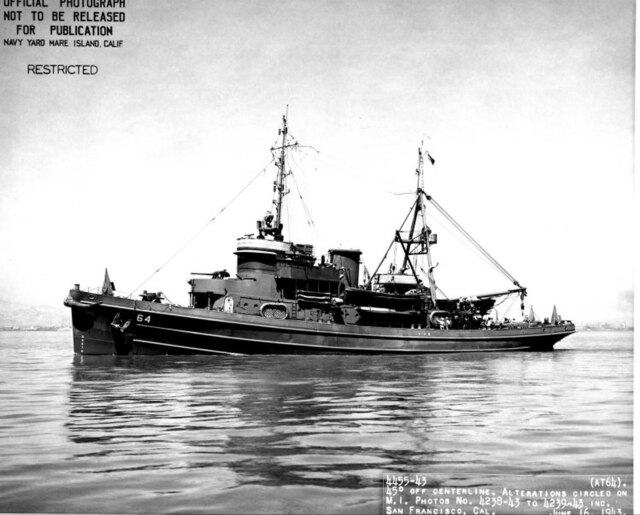 SwedenPhoto: Gustaf V of Sweden's 85th birthday, 16 June 1943, waiting in front of the Royal Dramatic Theater for the royal cortege. From the right: Defense Chief, Major General Axel Bredberg, Supreme Commander, General Olof Thörnell, Chief of the Navy, Vice Admiral Fabian Tamm, Chief of the Army, Lieutenant General Ivar Holmquist, Lieutenant General A. Hultkrantz, General Oscar Nygren, Chief of the Royal Swedish Naval Materiel Administration, Rear Admiral Gunnar Bjurner, Major General von der Lancken, Major General G. af Edholm and the Commandant of Stockholm, Major General Hugo Cederschiöld SwedenPhoto: Gustaf V of Sweden's 85th birthday, 16 June 1943, waiting in front of the Royal Dramatic Theater for the royal cortege. From the right: Defense Chief, Major General Axel Bredberg, Supreme Commander, General Olof Thörnell, Chief of the Navy, Vice Admiral Fabian Tamm, Chief of the Army, Lieutenant General Ivar Holmquist, Lieutenant General A. Hultkrantz, General Oscar Nygren, Chief of the Royal Swedish Naval Materiel Administration, Rear Admiral Gunnar Bjurner, Major General von der Lancken, Major General G. af Edholm and the Commandant of Stockholm, Major General Hugo Cederschiöld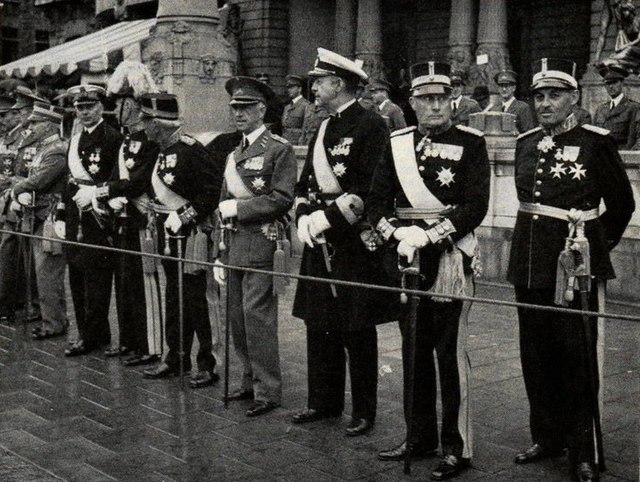 Pacific War Pacific War SOUTH PACIFIC THEATER OF OPERATIONS (Thirteenth Air Force) Search aircraft report nearly 250 Japanese airplanes at Rabaul on New Britain Island in the Bismarck Archipelago and other airfields jammed with aircraft. In air action in the Solomon Islands, about 120 Japanese aircraft converging on Allied vessels off Tulagi and Guadalcanal Islands in the Solomon Islands are met by more than 100 Allied fighters (USAAF, Royal New Zealand Air Force, US Navy and US Marine Corps). The skies over Savo and Tulagi, and Cape Esperance and Koli Point on Guadalcanal Island are filled with dogfights and flak from ship and ground guns. The battle results in the largest single-day Allied aerial victory of the Solomon Islands campaign; 79 airplanes are claimed shot down by Allied fighters, and AA claims 17 more; 6 Allied fighters are lost. The Japanese succeed in damaging 3 ships (2 of which have to be beached) and cause considerable destruction on Guadalcanal. Lost is B-24D 42-40250. Photo: Japanese air raid on Guadalcanal, 16 June 1943: A Japanese Aichi D3A "Val" dive bomber goes down smoking during the attack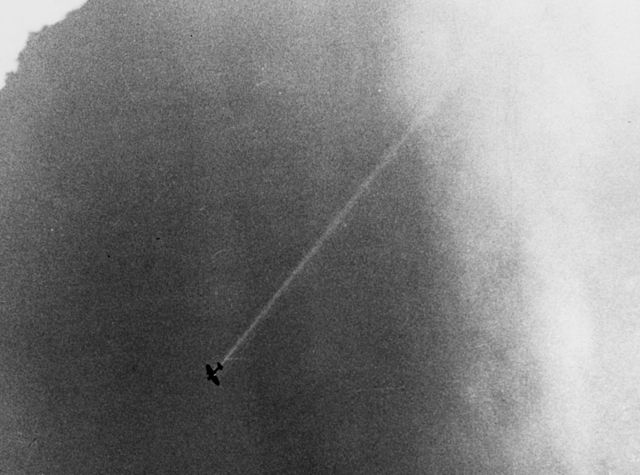 Photo: The U.S. Navy tank landing ship LST-340 burning after being hit by a Japanese bomb during the Japanese air raid on Guadalcanal, 16 June 1943. LST-340 was run ashore off Lunga Beach after being hit, and her fires extinguished after doing considerable damage to her and to her cargo. Another LST is visible here, assisting with firefighting Photo: The U.S. Navy tank landing ship LST-340 burning after being hit by a Japanese bomb during the Japanese air raid on Guadalcanal, 16 June 1943. LST-340 was run ashore off Lunga Beach after being hit, and her fires extinguished after doing considerable damage to her and to her cargo. Another LST is visible here, assisting with firefighting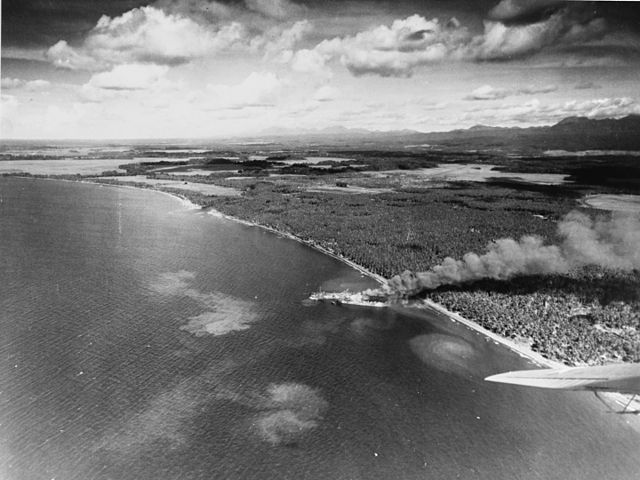 SOUTHWEST PACIFIC THEATER OF OPERATIONS (Fifth Air Force) B-25's bomb Koepang and Oeikoesi on Timor and, along with A-20's, hit barges and shore targets at several points along the coasts of NE New Guinea and New Britain Island in the Bismarck Archipelago. On a single bomber photo recon over Buka and Bougainville is B-17E "Lucy" 41-2666 two crew members earned the medal of honor.
|
|
lordroel
Administrator
Posts: 68,086 
Likes: 49,473
|
Post by lordroel on Jun 17, 2022 6:16:29 GMT
Day 1374 of World War II, June 17th 1943Air War over EuropeRAF No. 186 Squadron flying the Hawker Hurricane MK IID made the first rocket attacks against targets at Flushing in the Netherlands. The BBC warned civilians in occupied Europe to evacuate the vicinity of all factories working for the German war effort. 7 Mosquitoes, 4 to Berlin and 3 to Cologne and the Ruhr. No losses. Battle of the AtlanticHMT 'Yoma' sunk by 'U-81'. On 13 Nov, 1941 the boat, under the command of Guggenberger, sank the famous British aircraft carrier HMS 'Ark Royal' in the Mediterranean. An RAF No. 206 Sqdn Fortress damaged 'U-338', killing one and wounding three. The 'U-338' was nicknamed the 'Wild Onager' in reference to an incident that occurred when it was first launched. Apparently, the U-boat broke its moorings on the day of launch and sank a small tug boat. Battle of the MediterraneanUnited States naval vessels LST 6 and LST 326, were damaged by collision in the North African area. B-24s attacked airfields at Biscariy and Comiso, Sicily. During the night Wellingtons bombed docks and a marshalling yard at Naples, Italy. Preparations for the Allied invasion of Sicily continued as the British battleships 'Valiant' and 'Warspit' were transferred from the Scapa Flow in the North Sea to North Africa. Tank landing ships LST-6 and LST-326 are damaged in collision, North African area, 37°18'N, 09°51'E. United Kingdom
Photo: Army cadets demonstrate various forms of body camouflage, 17 June 1943![]()  Photo: Ground crews of No 300 (Polish) Squadron RAF work on their Vickers Wellington Mk Xs at RAF Hemswell in Lincolnshire, UK, June 17, 1943 Photo: Ground crews of No 300 (Polish) Squadron RAF work on their Vickers Wellington Mk Xs at RAF Hemswell in Lincolnshire, UK, June 17, 1943 Pacific War Pacific War CENTRAL PACIFIC THEATER OF OPERATIONS (Seventh Air Force) During the night of 17/18 Jun, 4 B-24's take off from Funafuti Atoll, Ellice Islands at 2-hour intervals to bomb Tarawa Atoll in the Gilbert Islands. One aborts and another fails to find the target. The 2 heavy bombers bombing the target hit runways, silence an AA battery, and blow up an ammunition dump. The raid is a diversion in support of the first night photo-reconnaissance mission by the VII Bomber Command, during which 3 B-24's photograph Mille Atoll and nearby waters in the Marshall Islands. CHINA (Fourteenth Air Force) P-40's strafe a warehouse and train S of Chiuchiang and a train N of Nanchang, both in China. Road traffic E of Hanoi, French Indochina is also attacked. SOUTHWEST PACIFIC THEATER OF OPERATIONS (Fifth Air Force) B-25's administer a thorough pounding to the Madang and Salamaua areas. B-24's bomb Sorong and Boela. A single B-24 bombs the airfield at Cape Gloucester on New Britain Island and, during the night of 17/18 Jun, a B-25 attacks power launches nearby, sinking 1 and badly damaging 2 more. The 433d Fighter Squadron, 475th Fighter Group transfers with P-38's from Charters Towers, Australia to Amberley Field, Townsville, Australia. PACIFIC Submarine chaser SC-740 sinks after running aground, 15°32'S, 147°06'E. Submarine Drum (SS-228) attacks Japanese convoy, sinking transport Myoko Maru about 175 miles east-northeast of Kavieng, New Ireland, 02°03'S, 153°44'E.
|
|
lordroel
Administrator
Posts: 68,086 
Likes: 49,473
|
Post by lordroel on Jun 18, 2022 13:59:25 GMT
Day 1375 of World War II, June 18th 1943YouTube (Kursk: Soviets Dig-In for Blitzkrieg)Air War over EuropeDr. R.V. Jones studied aerial reconnaissance photos of Peenemünde from June 12, and discovered what he concluded was a rocket, about 35 feet long, with five-foot diameter. The British "RDF" or "radiolocation" technology was renamed "radar". Battle of the AtlanticHMCS 'Athabaskan', a Tribal-class destroyer, Capt. George "Gus" Ralph Miles, OBE, RCN, CO, was damaged in a collision with boom defense vessel HMS 'Bargate' at Scapa Flow. This resulted in the destroyer being under repairs at Devonport for a month. 'Athabaskan' was dubbed "The Unlucky Lady" as the result of her many unfortunate escapades. In Apr 43, she was heavily damaged by weather and had to undergo major repairs. After her collision in June, she was hit by a German radio-controlled glider bomb on 27 Aug 43, which also required a lengthy period in a repair yard. 'Athabaskan' was sunk in action on 29 Apr 44 with heavy loss of life. Battle of the MediterraneanThe Allies "soften" Sicily with a pre-invasion bombing campaign. B-17s struck the Messina, Italy ferry slip and railroad yards while P-38s bombed the airfield at Milo, Sicily. B-26s and B-25s, with P-38 escort, hit docks and shipping at Olbia, Sardinia and shipping at Golfo Aranci, Italy. Northwest African Tactical Air Force (NATAF) and Northwest African Coastal Air Force (NACAF) airplanes maintained patrol and reconnaissance flights. Northwest African Air Force (NAAF) aircraft claimed over 40 aircraft destroyed. United States Photo: The U.S. Navy heavy cruiser USS Baltimore (CA-68) underway off the coast of Massachusetts (USA) on 18 June 1943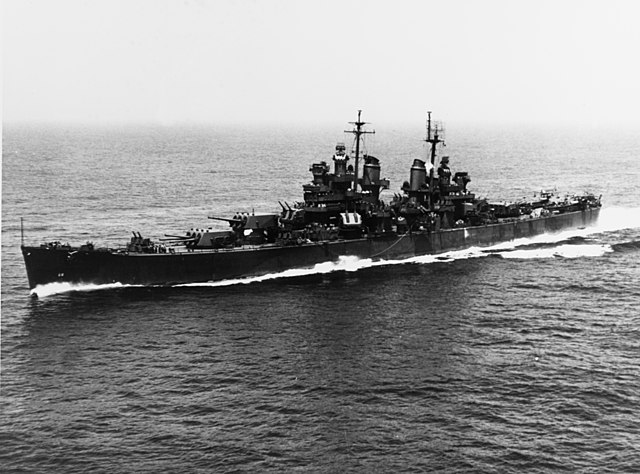 Pacific War Pacific War CENTRAL PACIFIC THEATER OF OPERATIONS (Seventh Air Force) The 58th Bombardment Squadron (Dive), Seventh Air Force begins a movement from Wheeler Field to Canton with A-24s. SOUTH PACIFIC THEATER OF OPERATIONS (Thirteenth Air Force) B-24's bomb Kahili Airfield while B-25's hit Ballale and strafe barges in Wilson Strait. SOUTHWEST PACIFIC THEATER OF OPERATIONS (Fifth Air Force) B-25's bomb and strafe power launches off Cape Gloucester, New Britain Island and Finschhafen, New Guinea, sinking 1 and damaging 2 near the Cape. A single B-17 bombs Unea Island, Bismarck Archipelago while an A-20 on armed reconnaissance during the night of 18/19 Jun bombs and strafes Salamaua, New Guinea and nearby coastal areas. INDIA General Auchinleck becomes Commander in Chief in India and General Wavell is the next Viceroy of India. These "promotions" are designed to move them to positions where Churchill feels safe. The other side of the appointments: Churchill had these fellows appointed less to "feel safe" than to use their talents where they could, in his estimation, be best used. Churchill failed to appreciate Wavell's many qualities as an operational commander and had written the Great Auk off as an administratively capable but operationally incapapble commander. In Churchill's view, both generals were also smeared with a propensity for ill-luck. AUSTRALIA Australian Prime Minister John Curtin announces that Australia is no longer in danger of invasion.
|
|
lordroel
Administrator
Posts: 68,086 
Likes: 49,473
|
Post by lordroel on Jun 19, 2022 6:36:33 GMT
Day 1376 of World War II, June 19th 1943
Air War over Europe
6 Mosquitoes went to Cologne, Duisburg and Dusseldorf. 12 Lancasters of 3 Group laid mines in the River Gironde, 1 Lancaster was lost.
During the month of June, the 40th Bombardment Wing arrived at Brampton Grange, England from the US.
181 Halifaxes, 107 Stirlings and 2 Lancasters went to bomb the Scneider armaments factory and the Breuil steelworks at Le Creusot, 2 Halifaxes lost. The tactics for this raid were that the Pathfinders would only drop flares and that each crew of the Main Fore was to identify their part of the target by the light of these flares. The Main Force crews were then to make two runs over the target area, dropping a short stick of bombs on each run from altitudes between 5,000 and 10,000 feet. By this stage of the war, however, Main Force crews were used to bombing target indicators and many had difficulty in making a visual identification of their target. Lingering smoke from the large number of flares was blamed for most of the difficulty. Bombing photographs showed that all crews bombed within 3 miles of the centre of the target but only about one-fifth managed to hit the factories. Many bombs fell on nearby residential property but no report could be obtained from France to give details of casualties.
26 of the H2S equipped Pathfinders who had released flares at Le Creusot were intended to fly on to drop flares over the electrical transformer station at Montchanin. By the light of these flares a further 26 Lancasters of 8 Group were to attack this second target. Most of the attacking crews, however, mistook a small metal factory for the transformer station and bombed that target instead. A few aircraft did identify the correct target but their bombs scored no hits on it.
Battle of the Mediterranean
During the night Northwest African Strategic Air Force(NASAF) Wellingtons bombed Syracuse, Sicily. An evacuation of civilians from Sicily and Naples was ordered by the Italian government.
In Italy, B-24s attacked ferry and railroad yards at Villa San Giovanni, ferries in the Straits of Messina, and the harbor of Reggio di Calabria.
North Africa
The British sapper was the victim of a German booby trap. He was bleeding badly. The explosion had almost severed his leg. A razor-sharp piece of shrapnel had penetrated his skull. When medical orderlies reached him, his life was in the balance. Only a miracle or skilled surgery could save him. The miracle - and the surgery - came in the form of a Dakota aircraft, complete with a surgeon, nursing orderlies and an operating theatre. Within an hour of the explosion, the fight to save Sapper X was taking place in mid-air. The shattered leg was amputated, the head wound prepared for more complex surgery in a hospital ship in Algiers. In any previous war, the victim would have stood little chance. But now, the RAF's "flying ambulance" service was playing a vital life-saving role on the battlefield. Nearly 3,000 lives are known to have been saved by the service in the desert campaigns. Only one-tenth of head-wound cases failed to survive. Major-General Freyberg, the New Zealand VC, owed his life to a flying ambulance after being picked up from a desert airstrip with severe neck wounds. It was a risky business for the personnel, flying in unarmed planes, often over Axis territory. One orderly received two bullets in the legs, but continued working until the patient was safely down - then collapsed from lack of blood.
A Ju 88D-1trop of 1(F)./122 was dispatched on a sortie to the Algerian Coast between Cap Bougaron and Oran. It failed to return and was believed to have been shot down by a fighter.
Battle of the Indian Ocean
U.S. freighter Henry Knox, en route from Fremantle, Australia, to Bandar Shahpur, Iran, is torpedoed and sunk by Japanese submarine I-37 at 00°05'S, 69°50'E. Although I-37 surfaces and conducts an extensive questioning of the survivors in one boat, the Japanese take no action against the men, who begin sailing toward the Maldive Islands, 200 miles distant, upon the enemy's departure (see 27, 28 and 30 June 1943).
Pacific War
CENTRAL PACIFIC THEATER OF OPERATIONS
(Seventh Air Force) During the night of 18/19 Jun, 2 B-24's fly photo reconnaissance of Jaluit Atoll in the Marshall Islands from Funafuti Atoll in the Ellice Islands.
SOUTH PACIFIC THEATER OF OPERATIONS
(Thirteenth Air Force) During the night of 18/19 Jun, B-24's bomb Nauru Island in the Gilbert Islands.
SOUTHWEST PACIFIC THEATER OF OPERATIONS
(Fifth Air Force) B-17's and B-24's thoroughly pound Vunakanau Airfield. A-20's hit barges in Hanisch Harbor and a trail near the village of Tamigudu, both in New Guinea. Single B-24's bomb Finschhafen, New Guinea area and the airstrip at Rapopo.
PACIFIC
Submarine Guardfish (SS-217) is damaged by depth charges north of Bismarck Archipelago, 02°00'N, 148°14'E, but remains on patrol.
Submarine Growler (SS-215), in attack on Japanese convoy on the Palau-to-Rabaul route, sinks army cargo ship Miyadono Maru about 200 miles north-northwest of Mussau Island, 01°38'N, 148°14'E.
Submarine Gunnel (SS-253) damages Japanese gunboat Hong Kong Maru (ex-Philippine Argus) and sinks merchant cargo ship Tokiwa Maru, off Shirase, Japan, 32°40'N, 126°37'E, and sinks coastal minesweeper Tsubame 32°31'N, 126°17'E.
Submarine Sculpin (SS-191) sinks Japanese guardboat No.1 Miyasho Maru and army cargo ship Sagami Maru off Inubozaki, Japan, 37°11'N, 142°30'E.
|
|



































